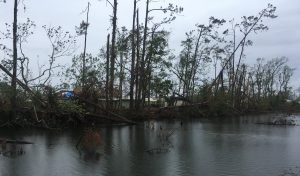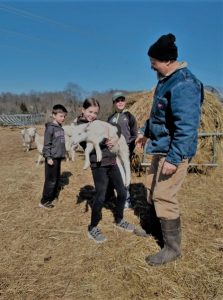This past week I spent the day visiting my hometown of Lake Charles, in Southwest Louisiana.

The old Calcasieu Marine (now Capitol One)
The first blue tarps appeared about 60 miles east of town, accompanied by the occasional snapped off tree or branch. By the time I was 20 miles out, the tarps and the trees alongside I-10 were joined by blown out billboards, crumpled metal buildings, piles of debris, and my growing sense of nervousness.
Driving into Lake Charles, a modest city of 78,000 and 200,000 in the metropolitan area, my sense that a catastrophe, an indiscriminate bomb of sorts, had hit, was overwhelming. I have driven through the aftermath of a tornado, and this was similar — but multiplied by a thousand. Instead of damage extending a few blocks, the swath of Hurricane Laura’s wrath reached 25 miles across. Estimates are that 95 percent of the buildings in the city itself sustained damage, and that does not include the impact to the areas directly outside the city limits or the parishes south and north.
I pulled off the interstate onto Enterprise Avenue, a major thoroughfare that cuts through the city north to south. Driving down the long-familiar street, I felt like I was being struck by a continuous gut punch. Eight weeks post-Laura and homes were still tarped, trees, belongings, and other debris still stacked high in yards and at curbside. Shuttered businesses — the triple hit of Covid, then Laura, then Hurricane Delta — haunted a landscape that will be fighting for years to try to recover. (The poorer side of town that I was driving through might just not make it at all.) Whatever financial resources a small-business owner might have had at the start of the year were gone, blown away.
Downtown, the old Calcasieu Marine building I helped build in 1982 stood as a silent memorial to 150-mile-an-hour winds: 22 floors of blown out windows, a contemporary folly to building a skyscraper on the Southern coastal plain. A few blocks away, a brother-in-law’s music venue lacked a second floor. It had spilled out onto the street like a ruptured bag of groceries during the storm. Throughout the city was the whine of chainsaws and tree crews mulching downed timber. The churches were not spared; one side was solid and welcoming of the faithful, the other side split open like a ripe melon, its pews and carpet piled up at the curb.
A landscape after a hurricane has hit is markedly open. Previously obscured buildings are now visible, a large percentage of the trees gone in a vast instant, as if a particularly greedy timber company has put in a big order.

the “open” landscape behind the family home
It was without surprise that I pulled into the family drive and was greeted by yet more splintered and severed trees and the ubiquitous tarped roof. Entering the house, I found my father, now 93, waiting at the kitchen table, along with a sister and niece. Rain from the approaching Hurricane Zeta (A record five hurricanes have hit the state so far this year) had poured onto the floor in what my sister jokingly called the “family swimming pool.” A living room that had sustained heavy damage from a fallen tree still waited on repairs by the overloaded construction crews. The house had been tarped and reinforced by another brother-in-law after Laura, but in a climate that deals in repeated storms, a thin layer of plastic is no substitute for an actual roof.
Throughout the day, family members collected for my visit to hang out, share stories, catch up. I remarked that this time the damage seemed more severe, much more so than for Rita. They all agreed. And if Rita was the benchmark for previous storm damage, then the catastrophic scope of Laura was off the chart.
But through it all I was struck by how resilient they all were. No one complained, just laughed off the destruction all around, if anything, grumbled the most about the never ending Covid restrictions. There were ongoing shortages, particularly of building supplies. Lake Charles is competing in its need with the rebuilding from the damage in the West Coast wildfires. And, of course, all of this is set to the backdrop of the ever-present pandemic and the related global supply chain deficiencies.
Schools are closed because of the pandemic and the storm damage. Senior care facilities are closed, their residents rehomed hours away in sister centers. Few restaurants are open, though many have food trucks parked in front of their buildings, serving meals as the work of cleanup goes on inside. Because most voting precincts were damaged, residents of all 34 citywide will vote on November 3 in the Burton Coliseum, the agricultural arena.
Hurricanes, like all disasters, test the mettle of a community. Some pitch in together, clear the debris, and rebuild. Some, riven by divisions and lack of will and resources, drift away and disintegrate. Lake Charles will likely be among the former, though there are areas, particularly in the poorer neighborhoods, that will need active assistance to get back to any degree of normalcy — whatever that looks like as we leave this year of 2020.
Late in the afternoon of my visit, as I drove out of town, I passed a stately live oak known as the Sallier Oak that serves as the symbol of the city. It had survived Laura in all its twisted beauty. Many of its leaves were missing, a few limbs gone, but it stood more or less as it had for 375 years, anchored in the earth of Southwest Louisiana. As I pulled onto the interstate and headed east, I smiled, thinking that that old tree was an apt metaphor for both my family and my hometown: battered yet still standing.




 on the bank of Contraband Bayou, a mile back through the dark woods of the old Barbe property, I am 10 years old, and fishing for alligator gar around midnight, the light of another full moon laying out a path across the sluggish water.
on the bank of Contraband Bayou, a mile back through the dark woods of the old Barbe property, I am 10 years old, and fishing for alligator gar around midnight, the light of another full moon laying out a path across the sluggish water.